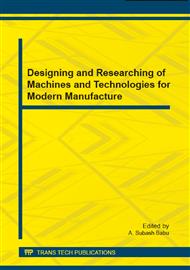p.436
p.441
p.447
p.451
p.456
p.460
p.465
p.469
p.473
Comparison of Vibration Signal Analysis Methods for Effective Gear Fault Detection
Abstract:
Reduction unit for high-speed train is an important component. However if faults of reduction unit occurred, the damages such as material and human damage have been caused. To prevent the damage, it is necessary to study reduction unit monitoring for high-speed train. We conducted spur gear specimen test which was crack, breakage and pitting tests and analyzed FFT, Sideband energy ratio (SER), RMS, crest factor, and kurtosis. There was not distinct difference between no-fault and pitting condition at RMS, crest factor and kurtosis. But SER increased depending on crack condition. In breakage test, all parameters had difference between no-fault and breakage condition.
Info:
Periodical:
Pages:
456-459
Citation:
Online since:
December 2014
Authors:
Keywords:
Price:
Сopyright:
© 2015 Trans Tech Publications Ltd. All Rights Reserved
Share:
Citation:


